New-incoming.email is a web-page that tricks computer users into subscribing to push notifications from this or similar web-sites that will in turn bombard users with popup ads usually related to adware, adult web pages and other click fraud schemes. This website will display the message ‘Click Allow to’ (watch a video, access the content of the web-page, verify that you are not a robot, download a file, confirm that you are 18+, connect to the Internet, enable Flash Player), asking user to subscribe to notifications.
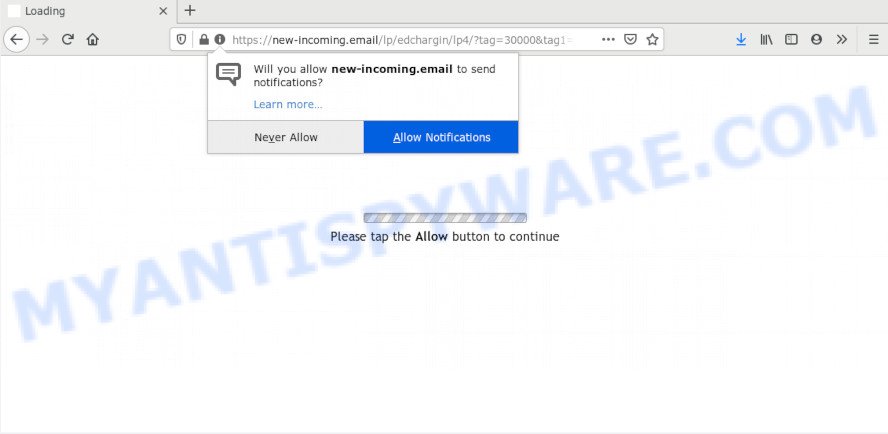
If you click on the ‘Allow’ button, the New-incoming.email webpage starts sending a ton of browser notification spam on your your desktop. You will see the pop up advertisements even when your browser is closed. The push notifications will promote ‘free’ online games, giveaway scams, dubious internet browser extensions, adult websites, and adware bundles like below.
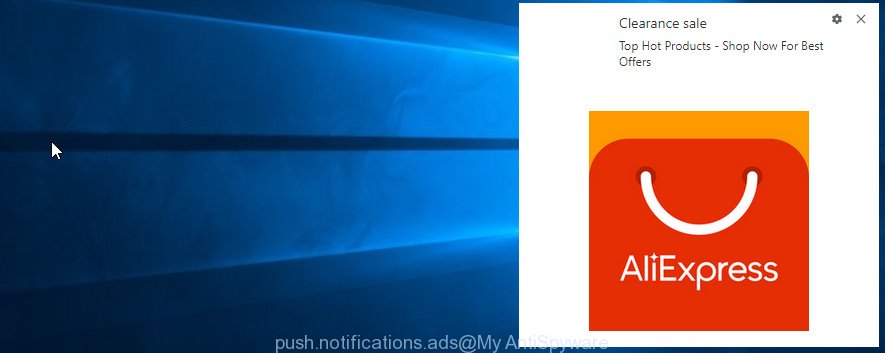
In order to unsubscribe from New-incoming.email spam notifications open your browser’s settings and perform the New-incoming.email removal guidance below. Once you remove New-incoming.email subscription, the spam notifications will no longer display on your screen.
Where the New-incoming.email popups comes from
These New-incoming.email popups are caused by shady advertisements on the websites you visit or adware. Adware is a part of malware. It is made to bombard you with endless advertisements and pop up windows that could potentially be dangerous for your system. If you get adware on your PC system, it can alter web browser settings and install harmful browser extensions.
Many of the freeware out there install unwanted web-browser toolbars, browser hijacker infections, adware software and potentially unwanted software along with them without your knowledge. One has to be attentive while installing free software in order to avoid accidentally installing third-party programs. It is important that you pay attention to the EULA (End User License Agreements) and choose the Custom, Manual or Advanced setup method as it will typically disclose what bundled applications will also be installed.
Threat Summary
| Name | New-incoming.email popup |
| Type | browser notification spam ads, pop-up ads, pop-ups, pop up virus |
| Distribution | adware softwares, potentially unwanted software, shady popup advertisements, social engineering attack |
| Symptoms |
|
| Removal | New-incoming.email removal guide |
Don’t panic because we’ve got the solution. Here’s a tutorial on how to remove annoying New-incoming.email popups from the Firefox, Microsoft Edge, Google Chrome and Internet Explorer and other browsers.
How to remove New-incoming.email popup advertisements (removal guidance)
Fortunately, it is not hard to get rid of adware software that causes multiple undesired popups. In the following instructions, we will provide two methods to clean your system of this adware. One is the manual removal method and the other is automatic removal method. You can select the way that best fits you. Please follow the removal guidance below to get rid of New-incoming.email ads right now!
To remove New-incoming.email pop ups, follow the steps below:
- How to delete New-incoming.email pop up advertisements without any software
- How to fully remove New-incoming.email pop up advertisements using free utilities
- Run AdBlocker to stop New-incoming.email popup advertisements and stay safe online
- To sum up
How to delete New-incoming.email pop up advertisements without any software
The step-by-step tutorial designed by our team will allow you manually delete New-incoming.email ads from your browser. If you have little experience in using computers, we suggest that you use the free utilities listed below.
Remove PUPs using MS Windows Control Panel
The process of adware software removal is generally the same across all versions of MS Windows OS from 10 to XP. To start with, it is necessary to check the list of installed software on your computer and delete all unused, unknown and questionable applications.
Make sure you have closed all web-browsers and other apps. Next, remove any unwanted and suspicious applications from your Control panel.
Windows 10, 8.1, 8
Now, press the Windows button, type “Control panel” in search and press Enter. Choose “Programs and Features”, then “Uninstall a program”.
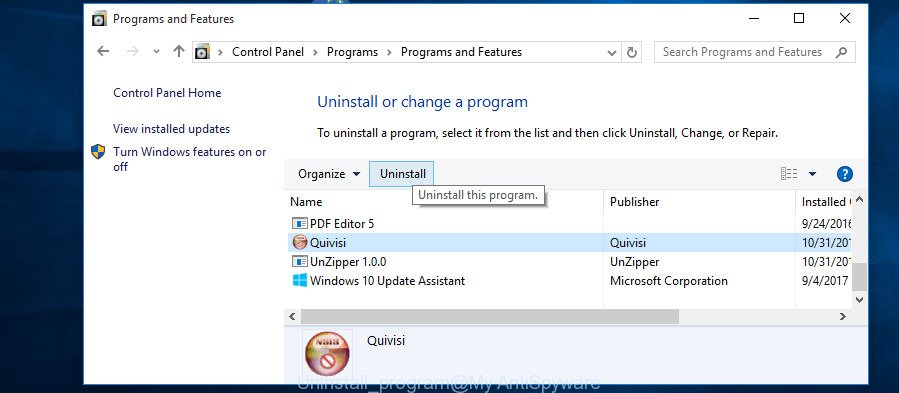
Look around the entire list of software installed on your computer. Most likely, one of them is the adware which causes unwanted New-incoming.email pop ups. Choose the questionable program or the program that name is not familiar to you and remove it.
Windows Vista, 7
From the “Start” menu in MS Windows, choose “Control Panel”. Under the “Programs” icon, choose “Uninstall a program”.

Choose the dubious or any unknown software, then click “Uninstall/Change” button to delete this unwanted application from your machine.
Windows XP
Click the “Start” button, select “Control Panel” option. Click on “Add/Remove Programs”.
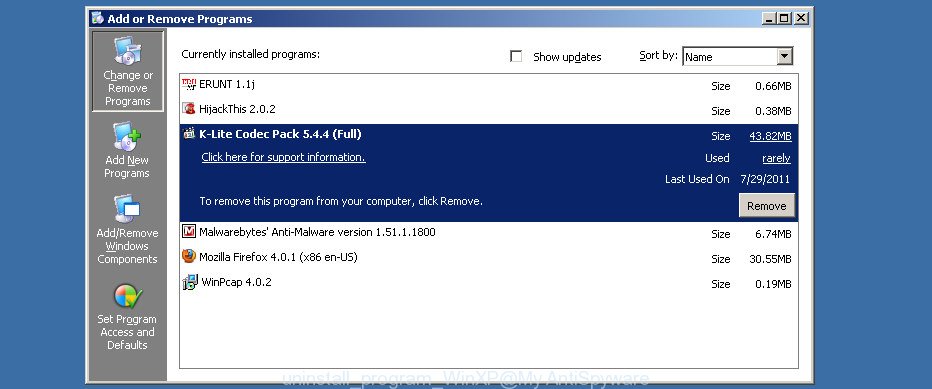
Choose an unwanted program, then press “Change/Remove” button. Follow the prompts.
Remove New-incoming.email notifications from internet browsers
If you have allowed the New-incoming.email site to send browser notification spam to your web browser, then we’ll need to remove these permissions. Depending on web-browser, you can use the steps below to delete the New-incoming.email permissions to send spam notifications.
|
|
|
|
|
|
Remove New-incoming.email ads from Google Chrome
If your Chrome browser is redirected to unwanted New-incoming.email page, it may be necessary to completely reset your web browser program to its default settings.
First open the Google Chrome. Next, click the button in the form of three horizontal dots (![]() ).
).
It will show the Chrome menu. Choose More Tools, then click Extensions. Carefully browse through the list of installed extensions. If the list has the extension signed with “Installed by enterprise policy” or “Installed by your administrator”, then complete the following guide: Remove Google Chrome extensions installed by enterprise policy.
Open the Chrome menu once again. Further, click the option named “Settings”.

The web browser will show the settings screen. Another way to display the Chrome’s settings – type chrome://settings in the internet browser adress bar and press Enter
Scroll down to the bottom of the page and press the “Advanced” link. Now scroll down until the “Reset” section is visible, as displayed below and press the “Reset settings to their original defaults” button.

The Google Chrome will display the confirmation prompt as shown in the following example.

You need to confirm your action, click the “Reset” button. The internet browser will start the procedure of cleaning. When it’s complete, the web browser’s settings including homepage, search provider by default and new tab back to the values which have been when the Chrome was first installed on your machine.
Get rid of New-incoming.email popups from Firefox
If your Mozilla Firefox web-browser is redirected to New-incoming.email without your permission or an unknown search provider opens results for your search, then it may be time to perform the web browser reset. It’ll save your personal information such as saved passwords, bookmarks, auto-fill data and open tabs.
First, start the Mozilla Firefox. Next, click the button in the form of three horizontal stripes (![]() ). It will show the drop-down menu. Next, press the Help button (
). It will show the drop-down menu. Next, press the Help button (![]() ).
).

In the Help menu click the “Troubleshooting Information”. In the upper-right corner of the “Troubleshooting Information” page click on “Refresh Firefox” button as shown in the following example.

Confirm your action, click the “Refresh Firefox”.
Remove New-incoming.email popups from IE
In order to restore all browser new tab page, search provider by default and homepage you need to reset the IE to the state, which was when the Microsoft Windows was installed on your PC system.
First, open the IE, then press ‘gear’ icon ![]() . It will open the Tools drop-down menu on the right part of the web-browser, then click the “Internet Options” like below.
. It will open the Tools drop-down menu on the right part of the web-browser, then click the “Internet Options” like below.

In the “Internet Options” screen, select the “Advanced” tab, then press the “Reset” button. The Microsoft Internet Explorer will open the “Reset Internet Explorer settings” dialog box. Further, click the “Delete personal settings” check box to select it. Next, press the “Reset” button as shown on the image below.

Once the procedure is complete, click “Close” button. Close the Internet Explorer and reboot your personal computer for the changes to take effect. This step will help you to restore your internet browser’s search provider by default, startpage and new tab page to default state.
How to fully remove New-incoming.email pop up advertisements using free utilities
There are not many good free antimalware programs with high detection ratio. The effectiveness of malware removal utilities depends on various factors, mostly on how often their virus/malware signatures DB are updated in order to effectively detect modern malicious software, adware software, browser hijacker infections and other PUPs. We advise to run several programs, not just one. These applications that listed below will allow you remove all components of the adware from your disk and Windows registry and thereby remove New-incoming.email ads.
Automatically delete New-incoming.email pop up advertisements with Zemana Free
If you need a free tool that can easily remove New-incoming.email advertisements, then use Zemana Free. This is a very handy program, which is primarily designed to quickly search for and delete adware and malware affecting web-browsers and modifying their settings.
Click the following link to download Zemana Anti-Malware. Save it to your Desktop so that you can access the file easily.
164814 downloads
Author: Zemana Ltd
Category: Security tools
Update: July 16, 2019
After downloading is finished, close all apps and windows on your PC. Open a directory in which you saved it. Double-click on the icon that’s named Zemana.AntiMalware.Setup as on the image below.
![]()
When the installation begins, you will see the “Setup wizard” which will help you install Zemana Anti Malware on your personal computer.

Once setup is done, you will see window as displayed on the image below.

Now click the “Scan” button to begin checking your machine for the adware software responsible for New-incoming.email pop-ups. A scan may take anywhere from 10 to 30 minutes, depending on the number of files on your PC system and the speed of your computer. During the scan Zemana Anti Malware will find threats exist on your PC system.

After the scan is finished, a list of all threats detected is created. You may delete items (move to Quarantine) by simply press “Next” button.

The Zemana will start to remove adware software responsible for New-incoming.email pop up advertisements.
Scan your PC system and delete New-incoming.email popup advertisements with Hitman Pro
The HitmanPro tool is free (30 day trial) and easy to use. It can scan and delete malicious software, PUPs and adware in Google Chrome, Microsoft Internet Explorer, Microsoft Edge and Mozilla Firefox web browsers and thereby get rid of all unwanted New-incoming.email advertisements. HitmanPro is powerful enough to find and remove malicious registry entries and files that are hidden on the system.
Click the following link to download the latest version of HitmanPro for Windows. Save it on your Windows desktop.
After the downloading process is done, open the folder in which you saved it. You will see an icon like below.

Double click the HitmanPro desktop icon. After the utility is started, you will see a screen as displayed on the screen below.
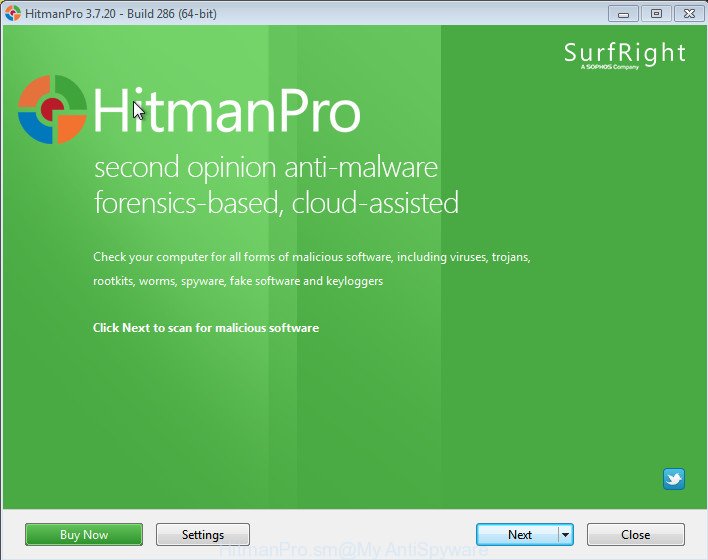
Further, click “Next” button to perform a system scan with this utility for the adware that causes intrusive New-incoming.email advertisements. A scan can take anywhere from 10 to 30 minutes, depending on the number of files on your computer and the speed of your personal computer. When the scan is complete, you can check all threats found on your system as shown below.
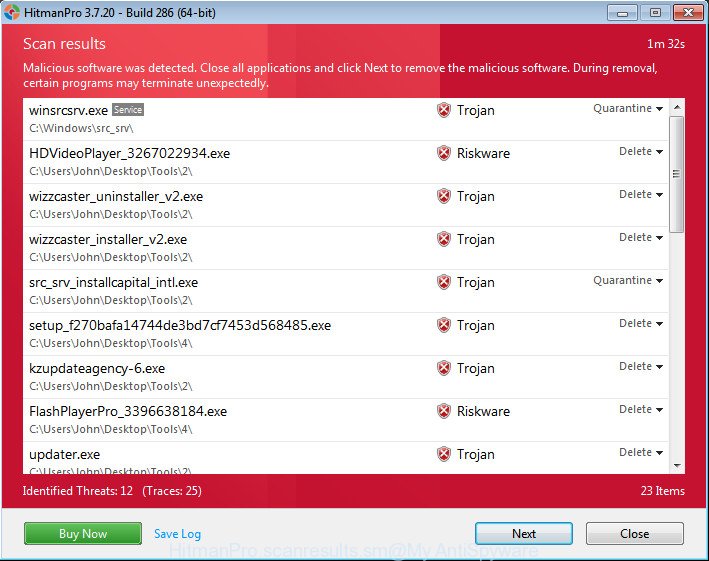
Review the results once the tool has complete the system scan. If you think an entry should not be quarantined, then uncheck it. Otherwise, simply press “Next” button. It will show a prompt, click the “Activate free license” button.
How to automatically get rid of New-incoming.email with MalwareBytes
If you’re having problems with New-incoming.email ads removal, then check out MalwareBytes Free. This is a tool that can help clean up your machine and improve your speeds for free. Find out more below.
Click the link below to download MalwareBytes Free. Save it to your Desktop.
327071 downloads
Author: Malwarebytes
Category: Security tools
Update: April 15, 2020
After the downloading process is done, close all apps and windows on your personal computer. Open a directory in which you saved it. Double-click on the icon that’s named mb3-setup like below.
![]()
When the install starts, you’ll see the “Setup wizard” that will help you install Malwarebytes on your personal computer.
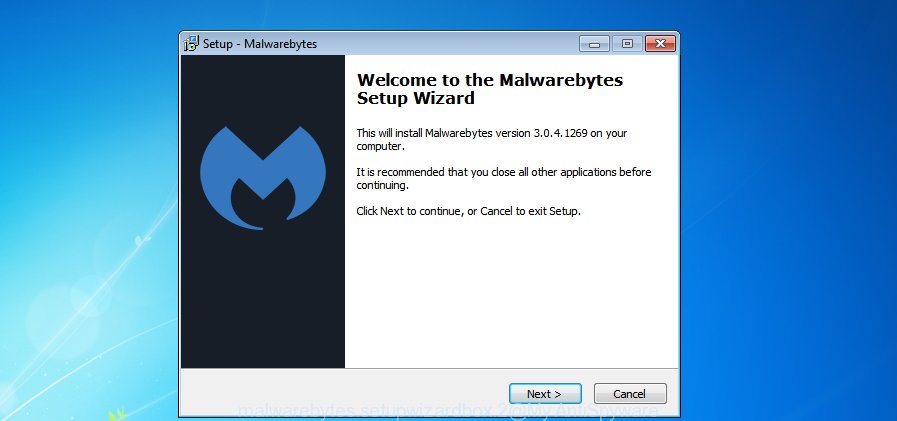
Once installation is done, you will see window as on the image below.
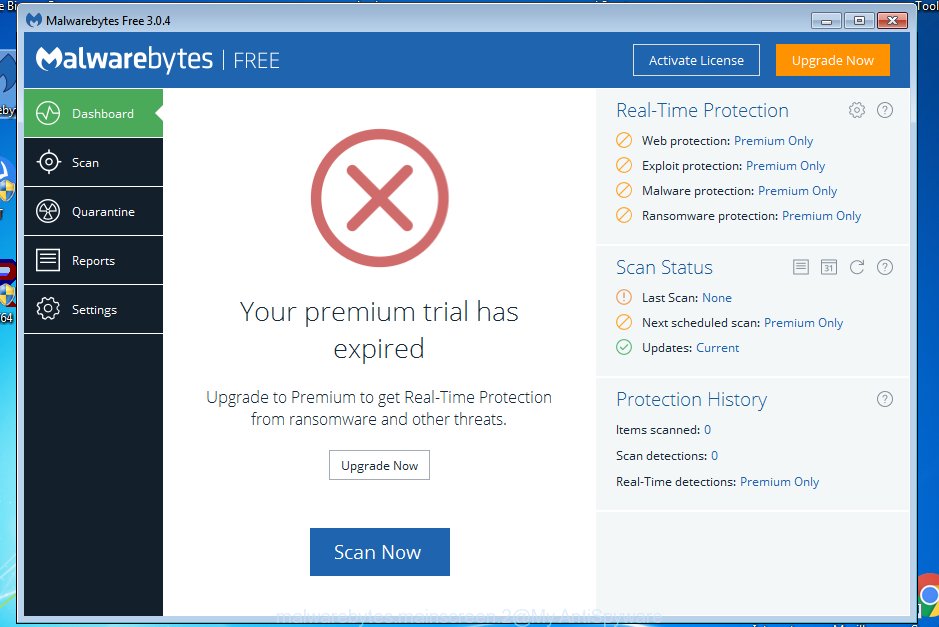
Now click the “Scan Now” button to perform a system scan for the adware software responsible for New-incoming.email popup advertisements. A system scan may take anywhere from 5 to 30 minutes, depending on your machine. During the scan MalwareBytes Anti-Malware will detect threats present on your system.
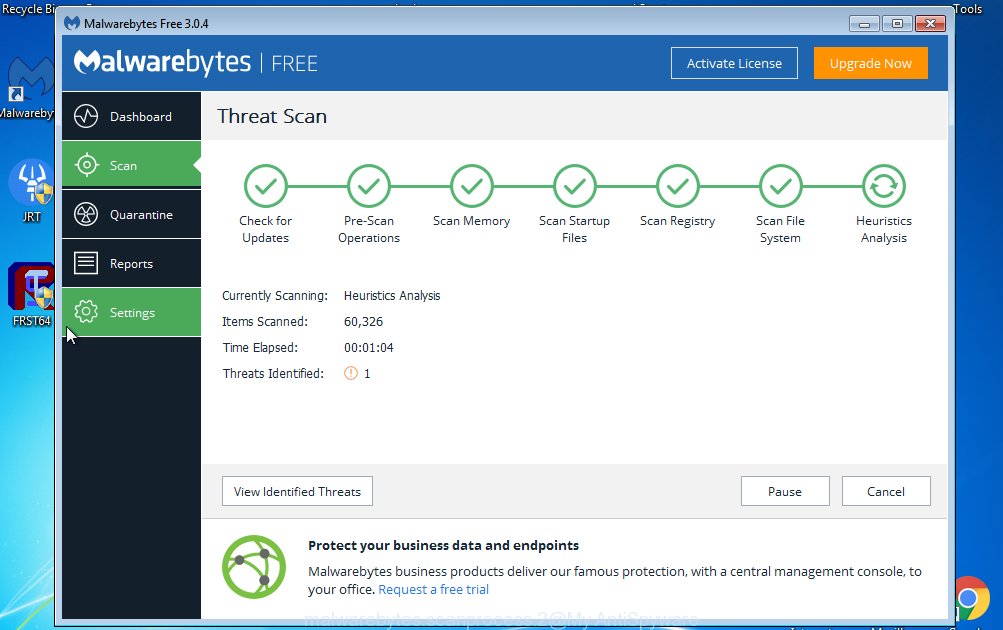
After the scan is done, MalwareBytes AntiMalware will produce a list of unwanted programs and adware. Make sure all items have ‘checkmark’ and click “Quarantine Selected” button.
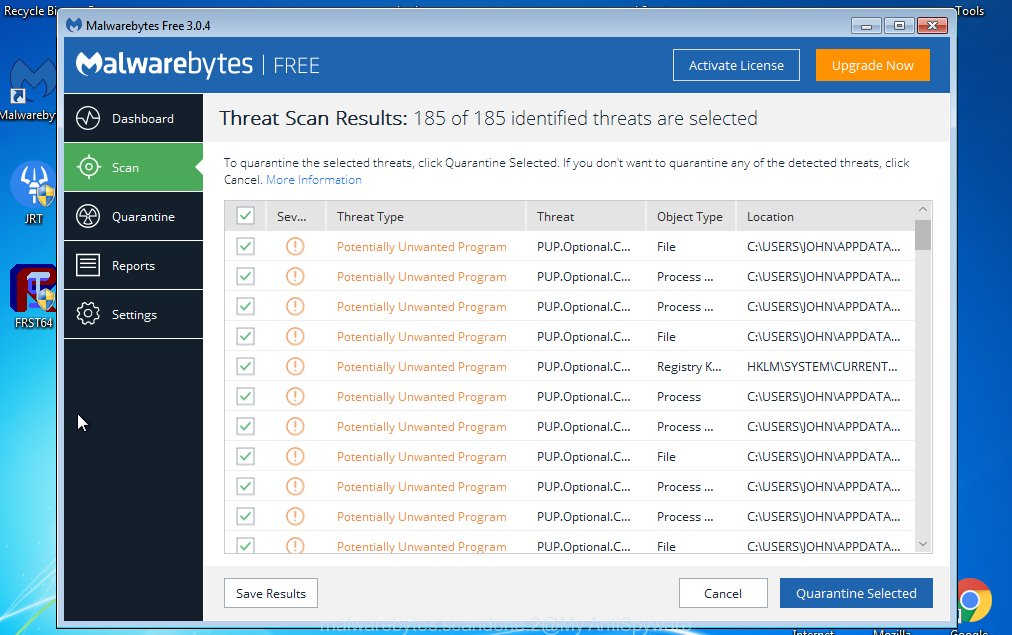
The Malwarebytes will now get rid of adware that cause popups and add threats to the Quarantine. When that process is finished, you may be prompted to reboot your personal computer.

The following video explains step-by-step tutorial on how to remove browser hijacker, adware and other malicious software with MalwareBytes Anti-Malware (MBAM).
Run AdBlocker to stop New-incoming.email popup advertisements and stay safe online
Enabling an ad blocking program like AdGuard is an effective way to alleviate the risks. Additionally, adblocker software will also protect you from malicious ads and webpages, and, of course, stop redirection chain to New-incoming.email and similar webpages.
- Visit the following page to download the latest version of AdGuard for Windows. Save it on your Windows desktop or in any other place.
Adguard download
26843 downloads
Version: 6.4
Author: © Adguard
Category: Security tools
Update: November 15, 2018
- After downloading it, launch the downloaded file. You will see the “Setup Wizard” program window. Follow the prompts.
- When the installation is done, click “Skip” to close the setup program and use the default settings, or press “Get Started” to see an quick tutorial that will allow you get to know AdGuard better.
- In most cases, the default settings are enough and you do not need to change anything. Each time, when you run your PC system, AdGuard will run automatically and stop undesired ads, block New-incoming.email, as well as other malicious or misleading webpages. For an overview of all the features of the program, or to change its settings you can simply double-click on the icon named AdGuard, which can be found on your desktop.
To sum up
After completing the steps outlined above, your machine should be clean from this adware software and other malware. The Firefox, Edge, Microsoft Internet Explorer and Google Chrome will no longer open undesired New-incoming.email web-page when you browse the Net. Unfortunately, if the steps does not help you, then you have caught a new adware, and then the best way – ask for help.
Please create a new question by using the “Ask Question” button in the Questions and Answers. Try to give us some details about your problems, so we can try to help you more accurately. Wait for one of our trained “Security Team” or Site Administrator to provide you with knowledgeable assistance tailored to your problem with the annoying New-incoming.email ads.


















